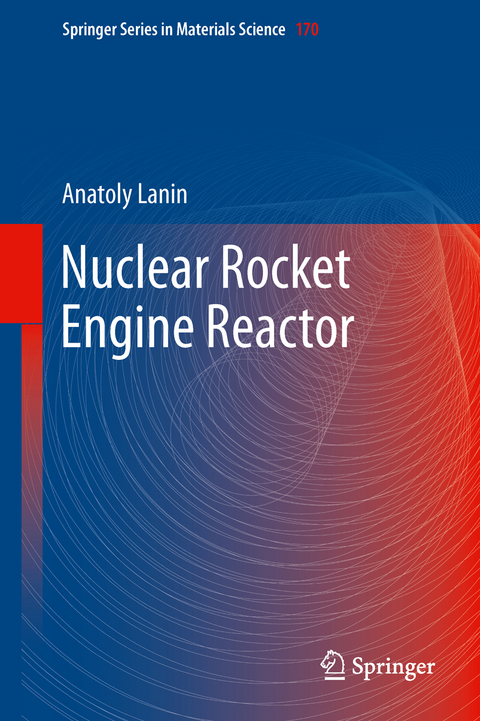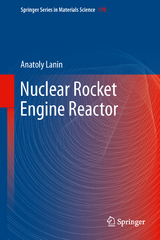Nuclear Rocket Engine Reactor
Seiten
2012
|
2013
Springer Berlin (Verlag)
978-3-642-32429-1 (ISBN)
Springer Berlin (Verlag)
978-3-642-32429-1 (ISBN)
This book details the development of a nuclear rocket engine reactor, based on simulation experiments and prototype reactor test data. Covers properties and performance of materials and fuels, and reviews prospects for use in piloted and drone spacecraft.
This monograph recounts and details the development of a nuclear rocket engine reactor (NRER). In particular, it explains the working capacity of an active zone NRER under mechanical and thermal load, intensive neutron fluxes, and high-energy generation (up to 30 MBT/l) in a working medium (hydrogen) at temperatures up to 3100 K. The design principles and bearing capacity of reactors area discussed on the basis of simulation experiments and test data of a prototype reactor. Property data of dense constructional, porous thermal insulating and fuel materials such as carbide and uranium carbide compounds in the temperatures interval 300 - 3000 K are presented.; technological aspects of strength and thermal strength resistance of materials are also considered. As well, a procedure to design possible emergency processes in the NRER is developed and risks for their origination are evaluated. Finally, prospects for use in pilotless space devices and piloted interplanetary ships are reviewed. The development of a nuclear rocket engine reactor (NRER ) is presented in this book. The working capacity of an active zone NRER under mechanical and thermal load, intensive neutron fluxes, high energy generation (up to 30 MBT/l) in a working medium (hydrogen) at temperatures up to 3100 K is displayed. Design principles and bearing capacity of reactors area discussed on the basis of simulation experiments and test data of a prototype reactor. Property data of dense constructional, porous thermal insulating and fuel materials like carbide and uranium carbide compounds in the temperatures interval 300 - 3000 K are presented. Technological aspects of strength and thermal strength resistance of materials are considered. The design procedure of possible emergency processes in the NRER is developed and risks for their origination are evaluated. Prospects of the NRER development for pilotless space devices and piloted interplanetary ships are viewed.
This monograph recounts and details the development of a nuclear rocket engine reactor (NRER). In particular, it explains the working capacity of an active zone NRER under mechanical and thermal load, intensive neutron fluxes, and high-energy generation (up to 30 MBT/l) in a working medium (hydrogen) at temperatures up to 3100 K. The design principles and bearing capacity of reactors area discussed on the basis of simulation experiments and test data of a prototype reactor. Property data of dense constructional, porous thermal insulating and fuel materials such as carbide and uranium carbide compounds in the temperatures interval 300 - 3000 K are presented.; technological aspects of strength and thermal strength resistance of materials are also considered. As well, a procedure to design possible emergency processes in the NRER is developed and risks for their origination are evaluated. Finally, prospects for use in pilotless space devices and piloted interplanetary ships are reviewed. The development of a nuclear rocket engine reactor (NRER ) is presented in this book. The working capacity of an active zone NRER under mechanical and thermal load, intensive neutron fluxes, high energy generation (up to 30 MBT/l) in a working medium (hydrogen) at temperatures up to 3100 K is displayed. Design principles and bearing capacity of reactors area discussed on the basis of simulation experiments and test data of a prototype reactor. Property data of dense constructional, porous thermal insulating and fuel materials like carbide and uranium carbide compounds in the temperatures interval 300 - 3000 K are presented. Technological aspects of strength and thermal strength resistance of materials are considered. The design procedure of possible emergency processes in the NRER is developed and risks for their origination are evaluated. Prospects of the NRER development for pilotless space devices and piloted interplanetary ships are viewed.
Preface.- History creation of a nuclear rocket engine reactor (NRER).- Design of a NRER.- Methods of modeling tests.- Materials of the reactor core.- Radiation durability of NRE elements.- Corrosion of materials in a working environment .- Bearing ability of NRE elements .- Prospects of the NRER development for space.
| Erscheint lt. Verlag | 17.10.2012 |
|---|---|
| Reihe/Serie | Springer Series in Materials Science |
| Zusatzinfo | X, 110 p. |
| Verlagsort | Berlin |
| Sprache | englisch |
| Maße | 155 x 235 mm |
| Gewicht | 350 g |
| Themenwelt | Naturwissenschaften ► Physik / Astronomie ► Atom- / Kern- / Molekularphysik |
| Schlagworte | Construction of nuclear reactors • Nuclear fuel materials • nuclear reactors • Nuclear rocket engine |
| ISBN-10 | 3-642-32429-0 / 3642324290 |
| ISBN-13 | 978-3-642-32429-1 / 9783642324291 |
| Zustand | Neuware |
| Haben Sie eine Frage zum Produkt? |
Mehr entdecken
aus dem Bereich
aus dem Bereich
Buch | Softcover (2024)
Wiley-VCH (Verlag)
CHF 83,85




